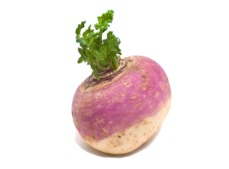Swede & Turnip

Swede and turnip crops are grown for the table and also for livestock as a means of extending the grazing season as grass growth and quality declines into the autumn season. The advantage of the swede is that it matures later, taking 150-180 days to maturity and is frost resistant, so can be left in the ground over winter if necessary. The top growth can also be cooked and eaten in spring. Swede is a more popular vegetable than turnip these days, though the latter was the staple vegetable in Scandinavia before the potato was introduced.
One of the bigger problems growing these crops is their susceptibility to weed competition, both in the 6-8 week period from fast-growing weeds and later from tall competition from the likes of fat-hen and knot-grass. To compete with weeds these brassicas will grow a longer stem and unfortunately, the extra stem length comes at the expense of root development. Although brassicas should be grown on a rotation of 4 – 5 years to minimise club root and Phoma, 3 years is more realistic and satisfactory.
The soils needed to grow these crops should be deep, well drained and rich in all mineral nutrients, but not so dense as to inhibit root growth. Turnips prefer a pH of 6.0 - 6.5 whereas swedes prefer 7.0 - 7.5
The Dressing Process
Field Science tailored mineral dressings are always based on detailed soil analysis of the field to be treated. A member of our technical team will visit your farm to discuss and identify where we can help. Soil samples are then taken and the tailored dressings are based on the independent laboratory’s results.
The Single Crop Dressing is the best option for swedes and turnips to fit in with the recommended once in three year rotation.
The best time for application is just after emergence in the spring. The application rate is usually 25kg per hectare (10kg/ac) and the most effective method of application is to use an electric spinner (slug-pelleter) on a quad bike. The dressings are packed in 25kg bags, clearly labelled with the farm details, field name, application rate and bag weight.
weight.
